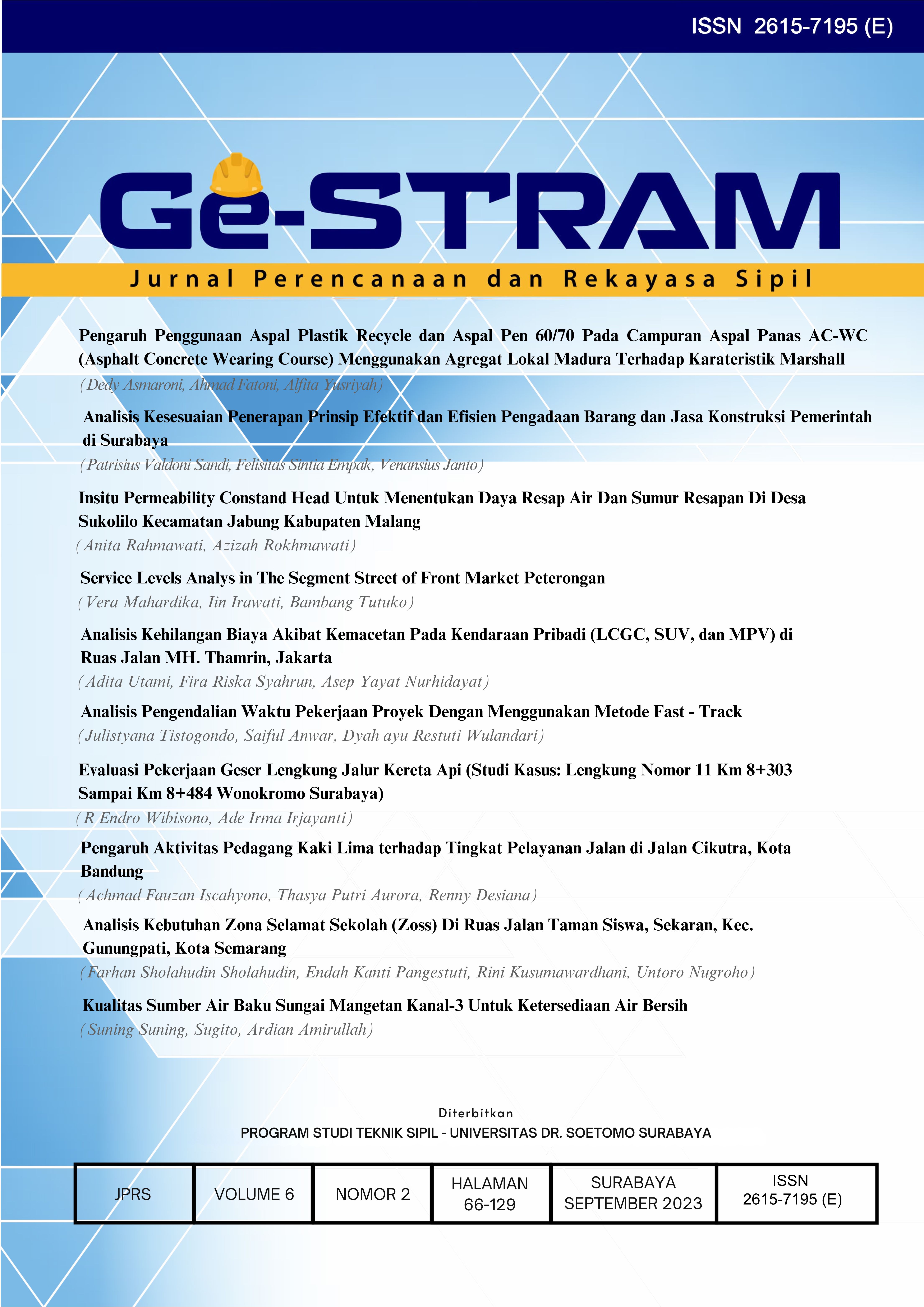Pengaruh Aktivitas Pedagang Kaki Lima terhadap Tingkat Pelayanan Jalan di Jalan Cikutra, Kota Bandung
 Abstract views: 296
,
Abstract views: 296
,
 PDF downloads: 598
PDF downloads: 598
Abstract
Street vendors around Cikutra Street are growing rapidly because of their location close to centers of community activity, such as residential locations, as well as education and health facilities. It causes the condition of the road network and facilities for pedestrians to not function properly. This study objectives to determine the impact of street vendor activity on the level of service on Cikutra Street, Bandung City. This research is a kind of quantitative studies in which the evaluation of level of road service uses the 2014 Indonesian Highway Capacity Guidelines. Based at the results of the analysis, the existence of street vendor activity along Cikutra Street has an influence on the level of road service. The existence of these street vendor activities has an impact on decreasing the level of service on Cikutra Street. This happens because it tends to be caused by travel delays, the physical condition of the street, the geometry of the street, and the volume of vehicle traffic flow on that street section. Even if the street vendors are abolished or relocated to other locations, the volume of vehicles will still be high because there are other commercial activities that are located on the edge of Cikutra Street and can affect the composition of vehicles passing through Cikutra Street.
References
Buana, L. Y. S., Abdilah, R. A., Rabinah, A. H., Risman, R., & Warsiti, W. (2022). Pengaruh Pedagang Kaki Lima dan Parkir Terhadap Kinerja Jalan di Kota Semarang. Bangun Rekaprima: Majalah Ilmiah Pengembangan Rekayasa, Sosial dan Humaniora, 8(1, April), 80-90.
Budi, S., Sihite, G., Indriastuti, A. K., & Priyono, E. Y. (2017). Perbandingan Kinerja Simpang Bersinyal berdasarkan PKJI 2014 dan Pengamatan Langsung (Studi Kasus: Simpang Jl. Brigjend Sudiarto/Jl. Gajah Raya/Jl. Lamper Tengah Kota Semarang). Jurnal Karya Teknik Sipil, 6(2), 180-193.
Direktorat Jenderal Bina Marga. (2014). Pedoman Kapasitas Jalan Indonesia (PKJI). Jakarta.
Faisal, R., Sugiarto, S., & Syara, A. (2017). Simulasi Arus Lalu Lintas Pada Segmen Penyempitan Jalan Akibat Pembangunan Fly Over Simpang Surabaya Tahun 2016 Menggunakan Software Vissim 8.0. Jurnal Teknik Sipil, 6(2), 183-194.
Khosasi, A. M., Kusumaningtyas, D. M., Halsted, T., & Sasongko, G. (2018). DILEMA TROTOAR Studi Kasus Dampak Pembangunan Trotoar terhadap Pedagang Kaki Lima di Salatiga. KRITIS, 27(2), 150-162.
Lalenoh, R. H., Sendow, T. K., & Jansen, F. (2015). Analisa Kapasitas Ruas Jalan Sam Ratulangi dengan Metode MKJI 1997 dan PKJI 2014. Jurnal Sipil Statik, 3(11).
Putranto, L. S. (2016). Rekayasa Lalu Lintas Edisi Ketiga. Jakarta: Indeks.
Rahayuni, I. G. A. A., & Citra, I. P. A. (2015). Pola Penyebaran Pedagang Kaki Lima (PKL) di Kota Singaraja. Jurnal Pendidikan Geografi Undiksha, 3(2).
Rosadi, T. D. (2019). Penggunakan Okupansi dan Komposisi Kendaraan Untuk Menentukan Ekivalensi Mobil Penumpang (Emp) pada Lalu Lintas Campuran di Bundaran Empat Lengan. Teras Jurnal, 9(2), 125-132.
Rukminingsih, Adnan, G., & Latief, M. A. (2020). Metode Penelitian Pendidikan: Penelitian Kuantitatif, Penelitian Kualitatif, Penelitian Tindakan Kelas. Yogyakarta: Erhaka Utama.
Sugiarto, S., Faisal, R., & Reyhan, M. (2018). Pengaruh Sepeda Motor Terhadap Kapasitas Bagian Jalinan Pada Perencanaan Bundaran di Simpang Tujuh Ulee Kareng. Teras Jurnal, 8(2), 416-425.
Sugiyono, D. (2018). Metode Penelitian Kuantitatif, Kualitatif, dan R&D. Bandung: Alfabeta. Bandung: Alfabeta.
Taime, H. (2021). Analisis Dampak Negatif yang Ditimbulkan Pedagang Kaki Lima Terhadap Pengembangan Tata Ruang Kota Timika, Kabupaten Mimika. Jurnal Kritis (Kebijakan, Riset, dan Inovasi), 5(2), 41-61.
Widjajanti, R. (2016). The Space Utilization by Street Vendors Based on the Location Characteristics in the Education Area of Tembalang, Semarang. Procedia-Social and Behavioral Sciences, 227, 186-193.
Copyright (c) 2023 Achmad Fauzan Iscahyono, Thasya Putri Aurora, Renny Desiana

This work is licensed under a Creative Commons Attribution-ShareAlike 4.0 International License.
Authors who publish with this journal agree to the following terms:
- Authors retain copyright and grant the journal right of first publication with the work simultaneously licensed under a Creative Commons Attribution-ShareAlike 4.0 International License that allows others to share the work with an acknowledgement of the work's authorship and initial publication in this journal.
- Authors are able to enter into separate, additional contractual arrangements for the non-exclusive distribution of the journal's published version of the work (e.g., post it to an institutional repository or publish it in a book), with an acknowledgement of its initial publication in this journal.
- Authors are permitted and encouraged to post their work online (e.g., in institutional repositories or on their website) prior to and during the submission process, as it can lead to productive exchanges, as well as earlier and greater citation of published work (See The Effect of Open Access).

This work is licensed under a Creative Commons Attribution-ShareAlike 4.0 International License.















